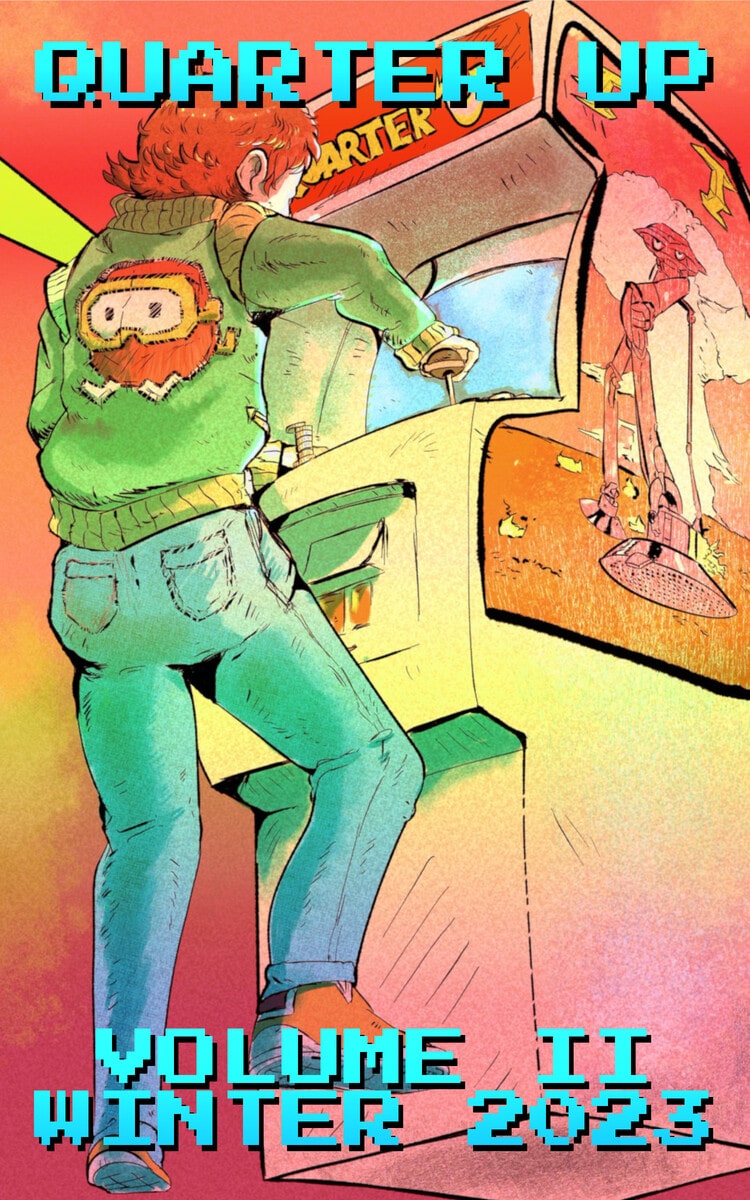
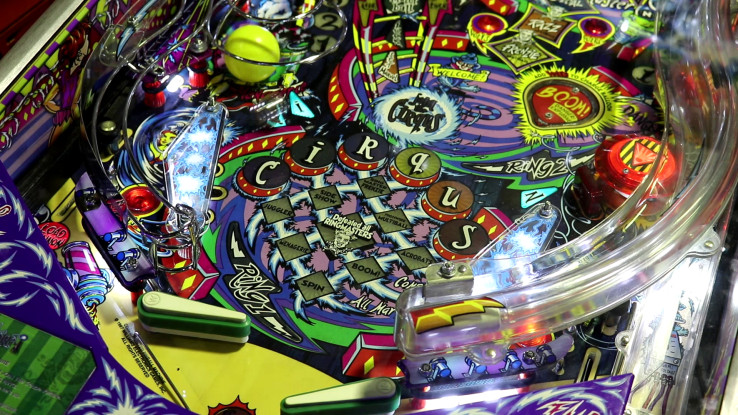
On November 9th, 2023 Houston Arcade & Pinball Expo returned to the Marriot Westchase on Briarpark Drive.
This year’s Expo took place on a very rainy weekend where the sky fell down for several days straight. Besides falling back into the routine of documenting the convention, my brother, our friend Miller Burruss1 and myself decided to contribute to the show: we participated as exhibitors for the first time ever. Miller volunteered his specially modified Wii for Smash(ing). We packed up our CRT television set and drove into the heart of the city. After Miller and I found our assigned table, we set up the display and tested everything. Afterwards, we did a figure-eight walkaround of both the vendors room and the ballroom, which serves as the main convention room. Gradually, the powers-that-be arrived in pickups and U-Haul trucks to wheel in over 160 pinball games (dating all the way back to the ’60’s) and about eighty arcade video games (going as far back as 1979) in the main showroom.

The vendors room featured over thirty gaming consoles and two dozen retro computers. Most of the home console hardware was provided by local enthusiasts such as Guru Guy Brian, Anton Gale, Aaron Elfstrom, and a few others. There were tried and true retro favorites like Super NES, N64, Sega Genesis, Nintendo GameCube, and the PlayStation 2. Some oddities that the average American doesn’t see every day made for great conversation pieces: the Famicom Twin, Casio Loopy, a modified Taito F3 and the Nuon (an attempt to turn DVD players into game consoles).

On Saturday night, musical acts like ’80’s tribute band Radio Duran and Radio Cult took to the center stage with Top 40 covers and their own quirky original tracks. Media guests included the internationally famous Harp Twins, actress Cindy Morgan (Tron, Caddyshack) Tim Kitzrow (the voice talent behind your favorite Midway sports games and so many classic Bally/Williams pinball tables), and Paul Niemeyer (artist on several Bally-Midway games such as the aforementioned Tron arcade game and Satan’s Hollow). World-renowned arcade expert Todd N. Tuckey roamed the convention floor, cell phone in hand.

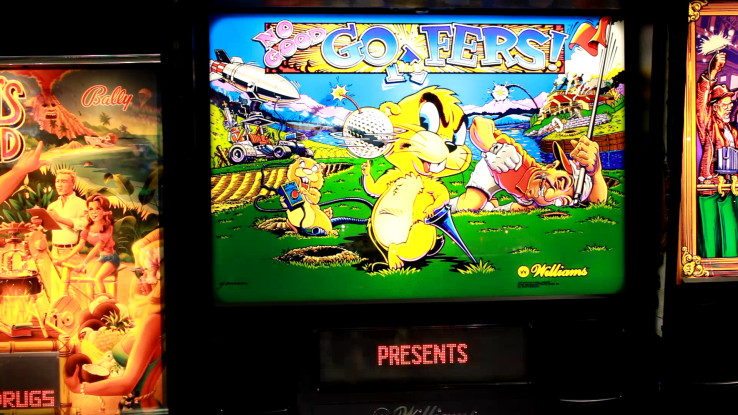
They not only had the Bally-Midway Tron game for Morgan’s arrival, the convention also had several playable mockups of the various fictional video games featured in the movie such as Light Cycles and Space Paranoids, all of which were attributed to Encom. Though there is no Caddyshack video game or pinball table, No Good Gofers by Williams was a featured pin game that takes a lot of inspiration from Caddyshack, with two mischievous gophers ruining a dilettante golfers’ time on the links.
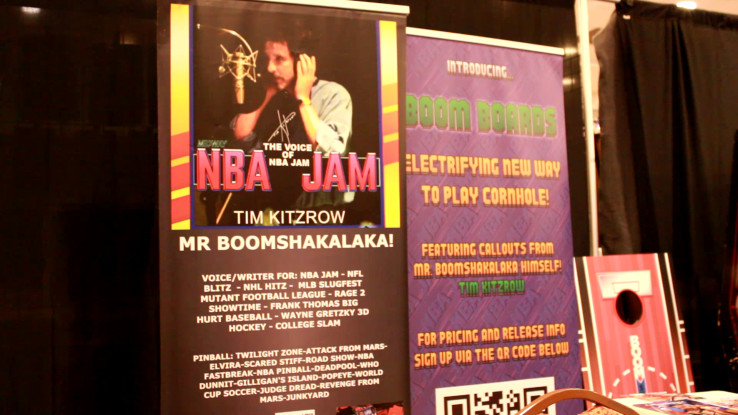
Both Kitzrow and Niemeyer’s booths were in close proximity to each other. The two later hosted their own panel about the Midway days (which I attended in 2022). I showed Niemeyer some pictures I took recently of Bally pinball games from the late ’70’s at The Game Preserve. I very briefly attended Morgan’s panel where she explained some of the challenges of filming Tron. I had previously met Tron actor Bruce Boxleitner in 2009; her anecdotes largely corroborate with his.
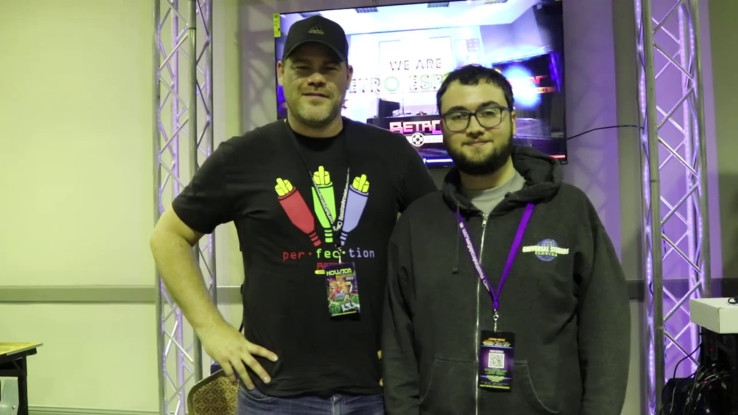
There were Japanese music games like Sound Voltex (a DJ simulator from Konami) and Project Diva: Hatsune Miku, based on the virtual pop idol. Gaming competitions both big and small were at the Expo. Hal Hawkings from Retro World Series hosted tournaments for Smash Bros, Power Stone, Mario Bros and Pong. There was even a quirky Paperboy score challenge by Drew Curlee where I ranked in third place! (there were only three participants). Historyofpinball.org had their own corner with Great Depression-era pin tables. Jeff Frick and Bryan Redshaw were very cooperative during the photography process by allowing us to film a few games without the glass and even gave me a run-through on the rulesets of games like Fleet, Juggle Ball and Cavalcade. Juggle Ball was one of the few games of its time that had a way to manipulate the ball aside from the plunge: there is a fireplace poker-like mechanism that can be used to guide the ball’s path.
Other flagship attractions were the latest from the modern pinball manufacturers: Venom and Foo Fighters from Stern, The Godfather by Jersey Jack Pinball, and Final Resentence for Multimorphic’s P3 system. Charles from Joystix provided these along with other recent favorites: Stern Jurassic Park, Deadpool (Pro), Avengers Infinity Quest, Cactus Canyon Remake, Guns ’n’ Roses: Not in this Lifetime, and others.

Above: Labyrinth pinball machines waiting for setup.
Houston’s very own Barrels of Fun took center stage with debut game: Labyrinth, based on the Jim Henson movie starring David Bowie. We attended their seminar on Saturday where we got to meet the developers and creative team. The panel was not a presentation but rather a Q&A: the discussion gave us insight about the development and the mindset the team was in to create the game. We received Barrels of Monkeys for participating.
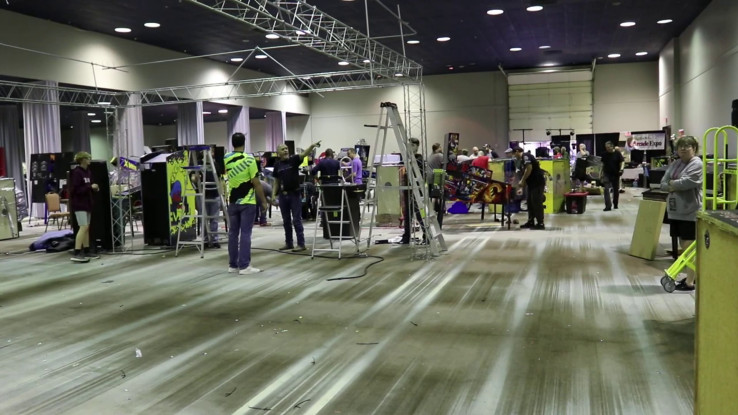
Crews striking down.
2:30 PM on Sunday was the official end of the convention, but not for me and Sam. Before we packed up, we shot the breeze with Joe Reyna from The Game Preserve and even got to witness some of the strikedown. This was a strange feeling for me. Five years ago, I was a simple convention-goer, and now I was involved in every single day of the convention, getting to see the very start and even far beyond the finish line.
What makes Houston Arcade Expo such a great experience is that it’s a gathering where professionals and hobbyists talk shop, play games and party. In this convention building, there are literally thousands of games to play; decades of distinguished technological history that you can touch, see and hear. Thanks to Keith Christensen, Erich Stinson, and all the wonderful Houston Area Arcade Group people and who make this extraordinary and unique event possible.
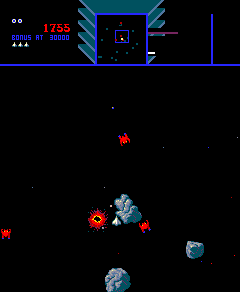
I first discovered Sinistar when I rented Midway Arcade Treasures for the GameCube in 2003. Immediately, I noticed something different from the other arcade titles in the collection. My first reaction was that Sinistar worked really well with the GameCube controller’s analog stick and that the smooth sprite rotation of the player ship was impressive for 1983.
As I was shooting at the enemies floating around me, out of nowhere a voice bellowed out the everlasting phrase: ”Beware, I live!”. Without warning, a giant skull-planet slingshots itself from the dark void of space and devours my spaceship, eliciting an unexpecting jumpscare. Compared to the simplicity of the other games in the collection, I was shocked by how modern Sinistar felt despite already being 20 years old in 2003. I had found a new favorite arcade game and my life was forever changed.
I needed to find out more. How did this game come together? Before the days of Wikipedia, searching for detailed information on the developmental history of a retro arcade game proved to be a mostly fruitless quest. But thankfully there were several production notes and interviews with software engineer RJ Mical (who’s currently Director of Games at Google) that were included in Midway Arcade Treasures. I was captivated reading about Sinistar’s development and RJ’s story of the elusive missing ROM set with the reduced difficulty settings. My fascination also led me to Noah Falstein, who I got to interview for my fan site when I was 15.
In March 2023, I was watching a video on YouTube about “Four-byte Burger”, a famous Amiga pixel art painting by Jack Haeger. When I heard the Haeger’s name, I realized he was the same person responsible for all the art assets in Sinistar, including the iconic marquee artwork. It brought back all my former enthusiasm for the game and my wish to obtain an easier version or to extract all the sounds.
Years ago, I attempted to reverse engineer the ROMs but never got anywhere due to a lack of understanding assembly languages. This time, I felt confident enough to dive into the binary data and figure out how the game works.
I got used to working with MAME’s debugger and eventually figured out how to get different sounds to play. This was done manually by setting up breakpoints in memory, hoping to find the routine responsible for handling sound calls. Once a valid sound call was found, the sound ID referenced was changed to make it play a different sound instead. This was a great primer for understanding 6800 and 6809 assembly code.
After I started my sound ROM project, I discovered the leaked Sinistar source code on GitHub. While I celebrated that we now had the potential to reduce the game’s difficulty, I was disappointed to find out that the sound ROM source code was kept separate from the repository and was missing. Thankfully, Williams Electronics software engineers reused several sound routines in their games, and some of these sound ROMs (Robotron, Defender, Stargate and Joust) have survived. Using these files as reference, I was able to reconstruct the source code to Sinistar’s Video Sound Rom 9 and 10, as well as implement the missing stereo sound (found exclusively in the cockpit cabinet) in MAME’s Sinistar driver. For a more detailed look at how this was achieved, you can watch my documentary about the lost source code and stereo sound.
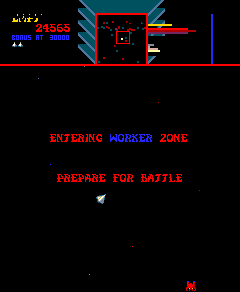
I became more familiar with the source code for the game logic and started to figure out how the difficulty settings worked. By September 2023, I had a better grasp on what was controlling the amount of lethal enemies that spawned into each zone.
Sinistar uses an internal difficulty timer called “DTimer”; this master clock increases every few seconds, and for every tick the population numbers change for the Workers, Warriors, and three of the five Planetoids. Another variable called “Warrior Aggression” (aka “WAgg”) increases with every tick, too.
Noah Falstein’s section of the code has the tables that list the initial population numbers and the rates for how fast the population increases or decreases for that enemy. The original game starts off with zero Warriors, but the high increase value of 16 ensures that a warrior will spawn very soon after the game starts. Once the player starts advancing to the next zone, new population numbers are loaded into memory and the numbers for the enemies increase to match with those predefined values. In the second zone, three warriors automatically spawn, but in the third zone ten warriors spawn. This creates the insane difficulty of the game: there’s just too many Warriors.
After hours of playtesting and fine tuning, I made a mod that reduces the increase rate for the Warriors but also reduces the amount of Warriors that spawn in the later zones. Only one warrior gets loaded at the start of the second zone, while three of them spawn at the start of the third zone. The WAgg variable remains unchanged, which means that the warriors continue to be aggressive and trigger-happy despite the reduced populations and rates. I felt it was important to keep Sinistar’s risk-and-reward gameplay.
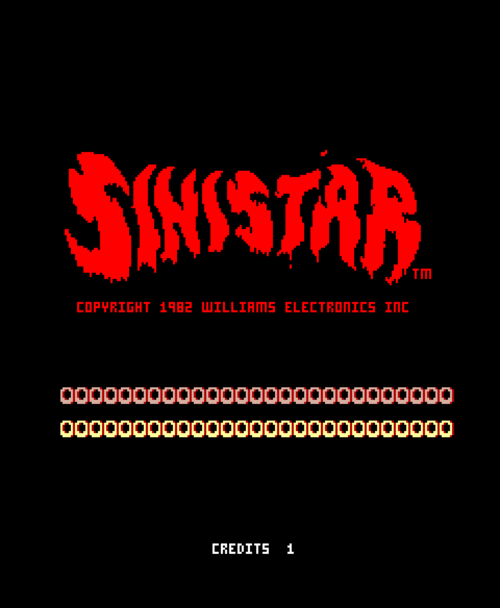
Above: Original screen for Sinistar.
I also was able to reinsert the original title screen from the AMOA ’82 prototype into the final version of the game. This was achieved by overwriting the RAM and ROM checksum tests and making the program skip those tests altogether.
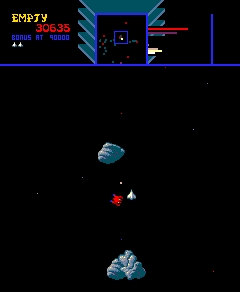
Any further modding of the game would need more reverse-engineering or even a rebuild of the game from the source code. This has been done before with mwenge’s source code rewrites for Defender and Robotron.
The codebase for Sinistar is massive compared to previous Williams games. On top of this, the assembler used to build the game is currently lost. In order to reassemble the game I would need to rewrite the source code to target a different assembler instead.
The code is split up into four folders, one for each of the main programmers:
- Sam Dicker was in charge of the multi-tasking game engine and executive critical stuff such as joystick control, displaying sprites, sound calls, etc.
- Rich Witt was responsible for handling collisions, gameplay logic like adding sinibombs, velocity and orbit tables for enemies, Sinistar’s lip sync animation, copyright protection, etc.
- As team lead, Noah Falstein handled routines for enemy AI and population numbers, as well as all the Sinistar speech calls.
- Finally, RJ Mical provided explosion effects, high score and status menus, and attract mode.
I deliberated for several months, pondering if it was possible to rewrite the Sinistar source code to make it a buildable game again. After conducting some tests with various 6809 assemblers and getting some promising results, I decided to take the risk and attempt the rewrite. Sinistar’s source code heavily relies on special custom instructions called macros to generate sections of code. For example, macros are used for creating text strings to be displayed on-screen or compressing the UI font sprites. Because of this, we needed an assembler that supports several different kinds of macros.
I went with Macro Assembler (AS) because it supports the same macros found in the Sinistar source code and the syntax it parses is very similar to what’s found in the codebase. This means would keep rewrites to a minimum.
As of now, the first quarter of the game is finished and the second quarter is halfway completed. I already confirmed that Sam’s code does build a usable ROM that loads into MAME. The game starts instantly after inserting a coin and pressing the Player 1 button. The scanner doesn’t work and there are no rocks or enemies to shoot at (in fact, the fire button doesn’t work). It’s just the player ship moving around in space. A very promising start to preserving this source code for future generations. You can follow the repository here:
github.com/synamaxmusic/sinistar
After uploading the Sinistar documentary on YouTube, I was watching a commercial for American Tourister where an actor in a gorilla suit smashes some suitcases. While destroying the luggage, the gorilla emits the same roar heard during Sinistar gameplay. This answered two questions: 1) it was not a sound effect recorded specifically for the game and 2) the sound must’ve been labeled as “gorilla” or something monkey or ape related.
It didn’t take long searching through vintage sound libraries before I struck gold. The roar came from a 1975 De Wolfe sound library and is labeled as “Gorilla Heavy Panting And Two Roars”. You can hear the Sinistar scream at 53 seconds.
It was rumored that the Sinistar roar was a recording of a lion made by the late Python Anghelo. I think this rumor began over confusion about the lion recording that appears on the promo Gorgar pinball record. That record featured Sinistar’s voice actor, John Doremus, adding to the confusion.
I never expected to achieve as much as I have with this game. I’m honored to share my findings with you. Sinistar is an important video game. With these discoveries and mods, we are making Sinistar more approachable and fun, while learning more about its development at Williams.

Abo’s Pizza in Louisville, Colorado had this upright Cruis’n USA cabinet, and an AC/DC pinball machine.
As the final quarter of 2023 winds down, let’s take a look back at the big pinball releases of the year. With only two major releases from Stern, companies like Jersey Jack, Multimorphic, and newcomer Barrels of Fun have picked up the slack.
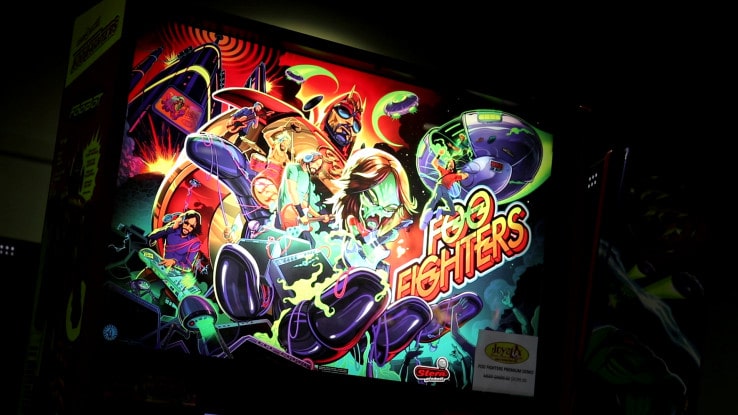
Based on the wildly popular rock act, FF came out in Spring 2023 with a wide release for both a Pro version and Premium version. FF is also the first fully original table designed by streamer Jack Danger (not counting a Stern Jurassic Park variant). The game has the Foo Fighters travel all over the United States in a rocket-powered Mystery Machine-like van battling an alien invasion lead by The Overlord by using the power of grunge music (“This is a Call” and “Breakout”).
I was able to catch the Premium model at Bishop Cidercade in Houston this August. One very cool and unique mechanic of the table is that if the left outlane is lit up, and you hold the left flipper down when you outlane drain, it activates a post that can bump the ball up from the center drain. This mechanic is called “Overdrive.” This flashy maneuver can not only score you big points, but also makes certain shots and events on the table possible.
Anyone who plays pinball knows that outlane drains are annoying. Some Stern tables like Star Wars have terrible outlanes that gobble up balls instantly. Designers at Stern like John Borg have made efforts to address this criticism, adding an extra inlane to games like Rush. Making outlane drains part of the risk-reward of FF’s ruleset is a more proactive approach.

The Premium model features a playfield toy of The Overlord as a ball lock mechanism for multiball, a mini-playfield and a decorative toy for the rocket-powered van. The Pro model step down from the Premium model. The Overlord toy gives a lot of personality to the game, and the lack of a mini playfield alters the flow and “wow factor” of the game. I found the game had a great variety of shots and a layout that was active but not cluttered. FF has something to offer newbies, seasoned players, and Foo Fighter fans alike.
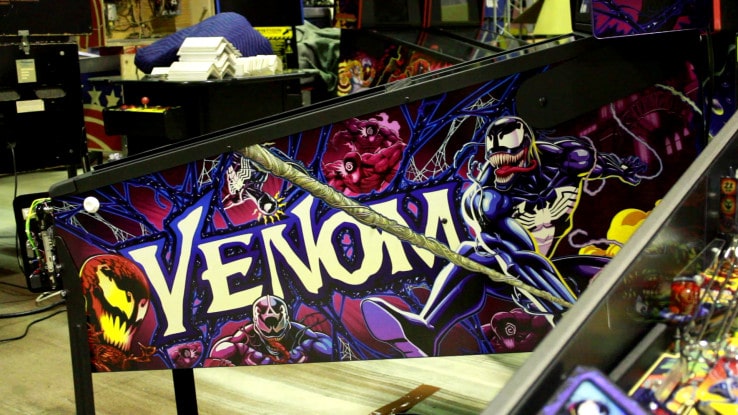
There were rumblings that the Fall 2023 Stern table would be based on Venom from the Marvel Universe before it was formally announced. I was under the assumption that it would take after the recent Venom films with Tom Hardy, but when the game was confirmed, it was revealed that it would actually be taking after the Marvel Comics themselves.
Another point of excitement was the news that it was going to be designed by Brian Eddy. Eddy is the designer for Attack From Mars and Medieval Madness which are two of the most acclaimed pinball games ever. Additionally, his Mandalorian table for Stern did very well.

In Venom Pinball, the before you start a round, you select a host for the Venom Symbiote to bond with (Peter Parker, Eddie Brock, Gwen Stacy, etc.) as they battle other Symbiotes. Which host you pick affects the gameplay. For example, Eddie Brock makes multiball easier to set up, Gwen allows for higher scores, etc. If you do well enough in the game, you can go beyond the Spiderverse and play as Venomized versions of Wolverine, Captain America and The Hulk.
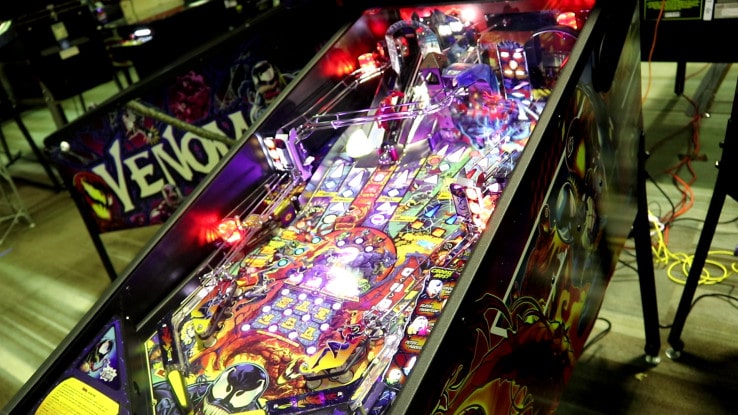
Brian Eddy’s games are known for their in-your-face aggression and agility and Venom is no different. Venom uses magnets to have a captive ball trade places with the active ball. It can really throw you off if you’re not ready for it. That confused the hell out of me during my initial play sessions and lead to some annoying drains (especially on the Pro version). Once again, I had better results with the Premium version, but the Pro Venom felt comparatively less compromised than the Pro FF.
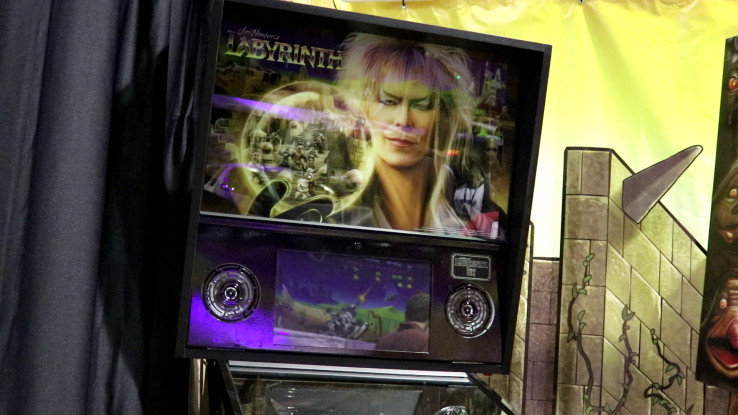
Labyrinth (based on the Jim Henson film) by Barrels of Fun is the first pinball game to be fully manufactured and designed in Houston. It debuted earlier this year at Chicago Pinball Expo 2023. Labyrinth is the first game designed by David Van Ess, formerly of Spooky Pinball. Me and my friends were able to try it out for the first time at Houston Arcade Expo 2023, where we met members of the creative team.
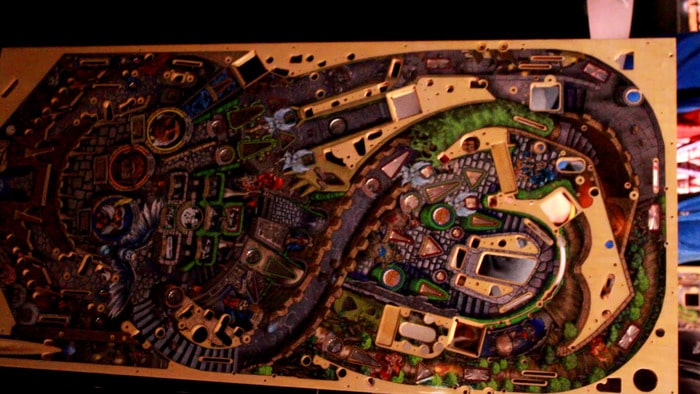
Expo Guests queued up en masse for a chance to play Labyrinth. I had not seen people line up for a pinball game since Deadpool in 2018. We even got to get up close and personal with the playfield. At the Barrels of Fun seminar, the team explained that part of their intent was to base the game around the idea of navigating through a fantasy labyrinth. Van Ess (who previously did animations for Spooky Pinball games) explained that he was frustrated by some decisions Sarah [Jennifer Connelly’s character — ed.] made in the movie. The ruleset and overall path of the game occasionally gives you prompts to go in a certain direction in the Labyrinth.
What stood out the most to me about Labyrinth was its clever use of hardware mechanics. The game uses posts and pistons to not only add to the ruleset, but to integrate characters into the game. When you outlane drain, one of the puppet stinkers from the movie pops out to mock you. In a rare display, Labyrinth features absolutely no jet bumpers. The light show of the game is absolutely beautiful. I found the multiball set up with the left orbit to be very consistent. With BoF insisting that there will be no more than 1,100 units made under any circumstances, Labyrinth is one to look out for.
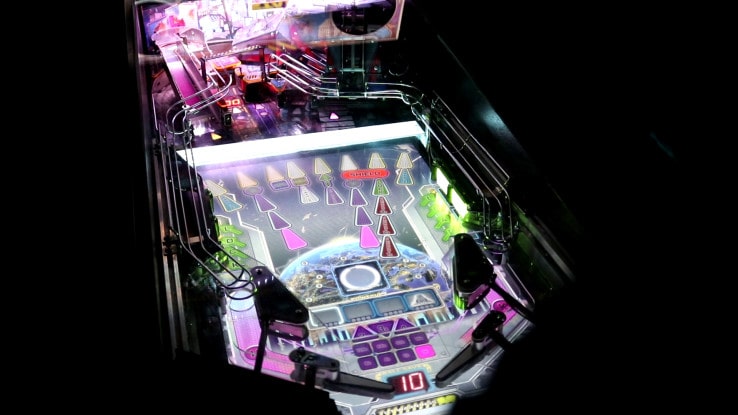
Final Resistance is the latest gameset for Multimorphic’s modular P3 hardware system; half screen/half playfield. In addition to co-designing the game, Scott Danesi did the music, sound effects and hardware mechanics. Famed pinball player Bowen Kerins also contributed to the design team. This is a science fiction-themed game where the player “joins the resistance” to battle bad guys in outer space. One of the multiball modes in the game has the ship on the playfield fire pinballs at you as you try to keep the balls in play.

After giving it a few runs, I can say Final Resistance has my favorite playfield design and mechanics of any Multimorphic game so far. The game has a speed and flow that the company’s previous games did not. Though I did enjoy games of theirs like Weird Al pinball, my brother and I had less issues with balls getting stuck in the corners. The overall feel of the game was just right.
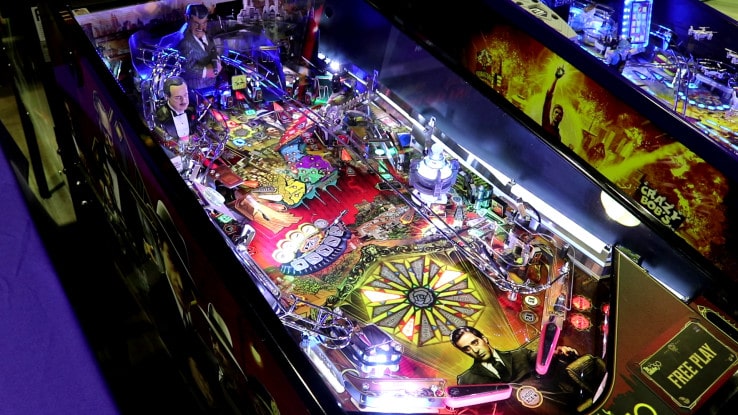
From Jersey Jack Pinball, The Godfather celebrates 50 years of cinematic excellence. In this game, the Five Crime Families of New York City (Corleone, Tattagli, Barzini, Cuneo, Stracci) engage in a turf war for control of the city. Before you begin a play session, you pick your family, all of which have their strengths and weaknesses. Just like with Toy Story 4 (one of Jersey Jack’s previous tables), Godfather has an internal motor that vibrates when events happen in the game and when the ball interacts with playfield toys and other hardware bits.
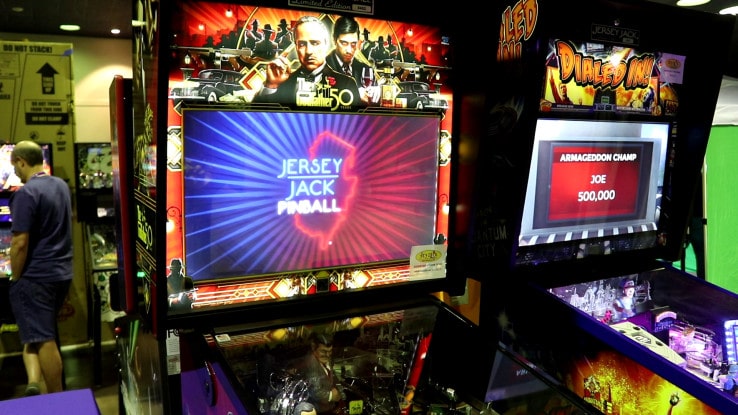
The game was mostly good, but I do question a few things about it. Who is their intended demographic? Will cinephiles flock to the game? The ruleset might be too complicated for casual players. The game progresses almost like a board game: everytime you hit you flipper, it causes a lane change; meaning that every time you hit the flippers, you might be putting yourself in a better or worse position on the board game portion of Godfather. Multiball was set up by hitting a cartoon gangster playfield toy. Though amusing, this does not have very much to do with the movies at all. It serves as a big contrast because he’s positioned right near a quasi-realistic sculpt of Vito Corleone. The premise of the game is a bit suspect as well. It simply runs contrary to the movies: because any Godfather fan knows that while it is cool to commit unlaw acts, crime does not pay.
And before we close this out, I’d like to give a shoutout to Elton John pinball by industry titan Steve Ritchie. The game is not quite yet on sale, but has toured around the country a bit.
Click here for a special offer from Buffalo!
The author Sinclair Lewis penned an epic about revivalism, lies, and fools called It Can’t Happen Here, and yet it has in so many ways. (The movie starred Burt Lancaster and he played the part to the hilt.)
Joe Bob Briggs (Kelly’s Verminator boss on Married With Children) started out in the ’70’s being a (fictional?) drive-in review critic from Grapevine, Texas, rating B-movies he saw at the drive-in. Sybil Danning always won the Hubby (hub cap, like an Oscar for drive-in awards) for the best rip-away bra and ‘popping her groceries.’ Briggs would close by saying, “There are no drive-ins in Russia. Without eternal vigilance it can happen here.”
Both are so true. It seems there are no more drive-ins or commercial pinball. Pinball was conquered by the great video lie, that it was better. Nothing was said about the repetition, how the problem, snag, or danger would always be at the same place or point, of how primitive AI played you to do certain things. Pac-Man was once the machine played by all; nowadays, try to find the machine.
The only requirement was remembering where it was and how to overcome it. No skill, no eye/hand coordination, no knowledge of geometry or physics, only a programming of memory and placement of the obstacle. In plain English, no brains required.
Pinball uses geometry and made us apply angles, when to flip to get the results (hopefully) of having the ball go where desired; a bit like hitting the baseball with a bat to go where desired (hopefully). Pinball is eye/finger response in a coordinated reaction. Saved me from getting hurt or injured more than once milking cows and with general situations in life.
One should never forget the number one rule with with pinball: ”The machine giveth and the machine taketh away.” Some you win, some you lose, so try again, you may win. The credo of slot machines and hooked gamblers. And video games and claw machines. And pinball. And with so much of every day living.
Or as Ray Davies of The Kinks sang:
“Have another drink, it’ll make you feel better.
Have another drink it’ll be all right.
If you’re down, if you’re under the weather
Have another drink it’ll be all right.”
I was recently informed by the editor that Quarter Up has been doing great thanks to you readers. I am shocked and humbled.
Never in my wildest dreams could I see myself being successful as a writer to a progressive publication. (Makes me feel a small bit like Herb Caen, a legendary “Rona Barret” of San Francisco writing about what had happened there. Five days a week. Whew.)
Pinball seems to have always been a part in my life. Going on a date and shooting pinball, or introducing her to the game. Traveling to see a friend and going out to shoot the ball. Seeking the game when traveling. But to write about it? Come on.
Anyway I wanted to say thank you very much, I hope you never have a tilt in your life or play. If you ever find yourself in Colorado or Denver area, you have one free game of pinball. Yes, I do have machines for public play, 25 cents a game with five balls per game, and if you make 100,000 or more points in one game, get a $10 reward.
The offer is good from January 2 to December 31, 2024.
For your free game come to Buffalo’s Last Stand in Cope and say “I’m a Quarter Upper.” You can’t miss the place as I am the only business in town. Be sure to see the Clark Kent changing room [phone booth — ed.] in the park: the original roadside attraction of Cope. (Buffalo’s Last Stand is the second roadside attraction. When you’re #2 you try harder.)
Spend a little time and I will regale you with stories, jokes, and who knows what else.
Thank you all for reading us and may the road be yours. Especially Highway 36.
Signing off as Cope’s only pinball ascetic,
Buffalo
399 Main St.
Lyons, Colorado 80540
Tournaments on the second Saturday of each month at 3 PM. $10 entry fee.
Women’s Tournaments on the third Saturday of each month at 3 PM. $5 entry fee, first-timers play free.
For more information, visit lyons
600 S. Center St.
Reno, Nevada 89501
Reno MatchPlay Pinball Tournament: December 16, 2023. Registration opens at 11:30 AM, tournament starts at 12 Noon. Registration is $10, with cash prizes for the top four places. Limited to the first 36 people registered on the day of the event.
“Pin-Brawl” Tournaments every Tuesday. Registration starts at 5 PM, tournament starts at 6:30 PM. $5 admission, with cash prizes for the top four places. Registration is limited to the first 48 people to register the day of the event. Limited to those 18 and older after 7 PM. This is an IFPA event.
For more information, visit reno
Nicholas Bernhard is the editor of Quarter Up. He is the developer of the Nantucket E-Books platform, and the Shanty markup language. With help from AT Gonzalez, he is building a directory of works by Harlan Ellison. For fun, he plays piano and bass guitar, and hikes. He may be reached at njb@
You may support his work at liberapay.com/nantucketebooks.
Originally from Pennsylvania, AT Gonzalez began his video game journey as a toddler playing Super NES. This opened up a whole new dimension of artistic expression for him. He began collecting games as a hobby a few years later down the line. His favorite game franchises are Mega Man, Mario, Metroid, Castlevania, F-Zero, Devil May Cry, Metal Gear, and plenty of others!
Currently based in Southeast Texas, he writes, makes short films, does studio photography, voice-over work, and audio production in his spare time. He may be reached at @At
You may support his work at ko-fi.com/atgonzalez.
SynaMax is an electronic music producer who started creating music and sound effects in 2004 at the age of 14. Some of his most well-known music includes a bootleg remix of Yello’s Oh Yeah (with over 213,000 views as of 2023) and his original music featuring sound design and compositions inspired by Kenji Yamamoto’s soundtracks from the Metroid Prime trilogy. His collection of sound effects from freesound.org have been used in various indie games such as Cry of Fear, Steel Assault, SCP: Containment Breach and Flappy Bird. TV programs that use SynaMax sounds include Regular Show and The Eric Andre Show. He is also a self-taught programmer and has been involved with reverse-engineering audio for games including Metroid Prime, Castlevania: Symphony of the Night, Snatcher (Sega CD), Cryo Interactive’s Dune and most recently, Sinistar.
SynaMax’s YouTube channel also features various videos related to video game sound. He is currently finishing up his final Metroid Prime-inspired album and is starting work on an original video game co-developed with his partner entitled Nested Dreams.
Check out synamax.bandcamp.com to purchase music or patreon.com/synamax to get early access to new tracks. Videos can be found at: youtube.com/synamax.
Buffalo is our resident color-commentator at Quarter Up, covering the places where life and pinball intersect. After spending most of his life in the San Joaquin Valley of California, he moved to Cope, Colorado on the eastern plains. There, he runs Buffalo’s Last Stand, where you can find all things bison-related, and eastern Colorado’s finest bookstore. He also bakes a mean cookie.
In 2023, his novel Tales of a Metal Fisherman, filled with adventures in the life of a hard-living repo man, was published by Nantucket E-Books. A sample of the book may be read by clicking here, or you may order the e-book and/or paperback at nan
Anna Frohling (Pencilforge) grew up a military brat who has moved 13 times. She has a Japanese history degree from UMUC, and an animation degree from a now-defunct Tucson art school. Specializing in creature design and webcomics, she currently lives in Elmwood, Illinois with her dog, Piper, and her Dreamcast collection.
You may find her art, and support her work, at patreon.com/pencilforge.
This issue of Quarter Up is © 2023 Nantucket E-Books, LLC. Copyright for the articles contained in this newsletter is reserved by their respective authors.
Check out these past issues of Quarter Up. If you like what we do, consider subscribing to our RSS feed, or check out the official Quarter Up page on nantucket
The history of Nibbler by Leland Tursi. An interview with Steve Mitchell of Classic Amusements, by Nicholas Bernhard. A promo for the Houston Arcade Expo 2023 by AT Gonzalez. Color commentary: Buffalo explores pinball and the blues in Denmark. Cover art by Brad Albright.
The legal woes of Ms. Pac-Man by AT Gonzalez. Arcade games seen on summer road trips. The History of Chack’n Pop by Leland Tursi. Color commentary: memories of pinball in Modesto, CA by Buffalo. Cover art by Jeremy Mendiola.
Coverage of Houston Arcade Expo 2022 by AT Gonzalez. A recap of a panel with Brian Colin (Rampage) by AT Gonzalez. Reader Q ’n’ A. An entry-level guide to arcade sticks by Miller Burruss. Color commentary: “Long Live Pinball” by Buffalo. Cover art by Kris Vaswig.
A brief history of pinball by Miller Burruss. Pinball terms you need to know, by AT Gonzalez. The history and leak of Marble Madness II by Carlos Martinez. Ten Pinball Machines that Changed the Game: an interview with Pinball Hall of Fame owner Tim Arnold. A history of the arcade game Mystic Marathon by AT Gonzalez. A promo for Houston Arcade Expo 2022. Color commentary: Meditation, Zen, and the Art of Pinball by Buffalo. Cover art by Christopher Jacobs.
TEXT © Nantucket E-Books LLC for newsletter.
DOWNLOAD ENTIRE E-BOOKThis e-reader was developed by Nicholas Bernhard, © 2020 - 2023 Nantucket E-Books™ LLC. Nantucket E-Books™ is built on free software, which means it respects the freedom of the writers and readers using it. For more information, check out the software license page, the Help page, or e-mail me at njb@nan